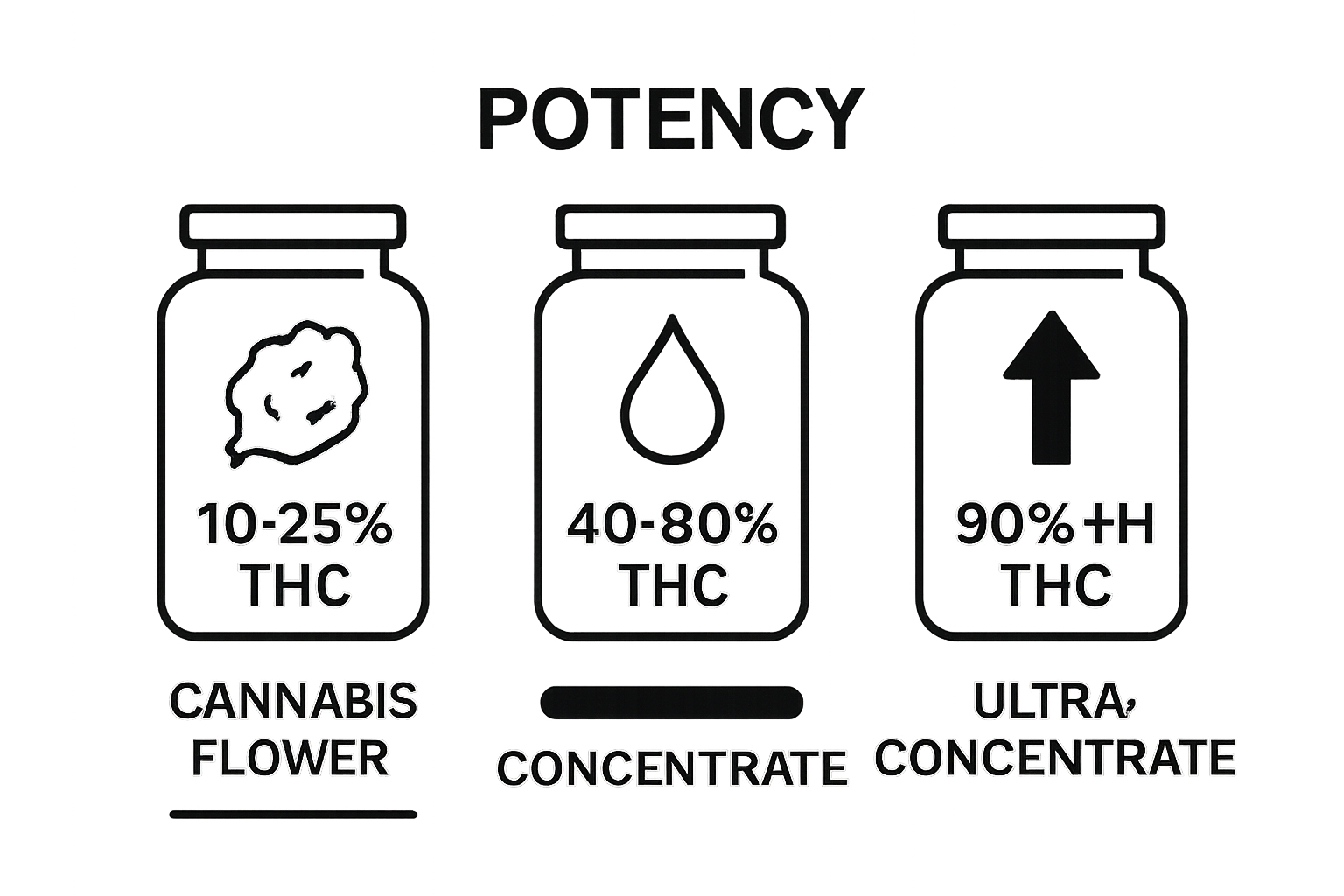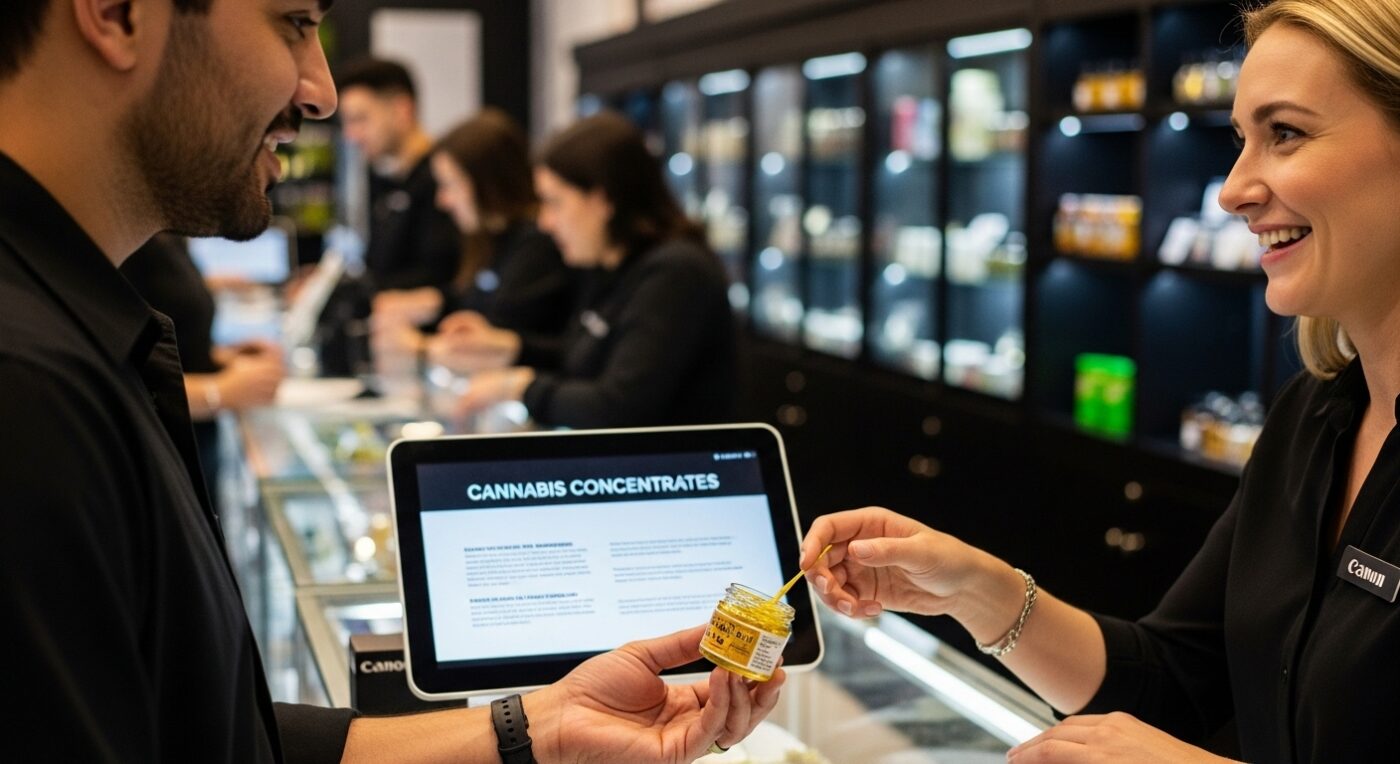Blog
Understanding What Are Cannabis Concentrates
Cannabis concentrates have taken the world by storm, delivering potency that leaves traditional cannabis flower far behind. Some of these products pack a staggering THC content of 90 to 95 percent, turning a tiny dab into a powerhouse experience. That sounds intense, right? Most people think such strength means danger or loss of control. In reality, concentrates can actually offer more precise dosing and targeted relief if you know what you’re doing.
Table of Contents
- Defining Cannabis Concentrates: What Are They?
- The Significance of Cannabis Concentrates in the Market
- How Cannabis Concentrates Are Made: A Scientific Perspective
- Key Types of Cannabis Concentrates and Their Uses
- Effects and Benefits of Using Cannabis Concentrates
Quick Summary
| Takeaway | Explanation |
|---|---|
| Cannabis concentrates are highly potent. | They typically have THC levels of 40% to 95%, offering more intense effects than traditional flower. |
| Extraction methods vary significantly. | Techniques include solvent-based, solventless, and heat pressure methods, each yielding different concentrate types. |
| Concentrates offer precise dosing. | Medical users can achieve targeted relief with smaller servings, enhancing treatment control. |
| Market growth reflects consumer demand. | The rapid expansion of cannabis concentrates indicates a shift towards more sophisticated consumption preferences and products. |
| Quality control is crucial. | Rigorous testing is needed to ensure safety and remove potential contaminants from concentrates. |
Defining Cannabis Concentrates: What Are They?
Cannabis concentrates represent a potent and refined category of cannabis products designed to extract and isolate the plant’s most desirable compounds. These concentrated forms deliver significantly higher cannabinoid and terpene content compared to traditional cannabis flower, offering users a more intense and targeted experience.
The Essence of Cannabis Concentrates
At their core, cannabis concentrates are extracted substances that capture the essential elements of the cannabis plant. According to research in Frontiers in Psychiatry, these products typically boast THC concentrations ranging from 40% to 80%, dramatically higher than the 10-25% found in standard cannabis flower. This substantial potency means users can achieve more pronounced effects with smaller quantities.

Extraction Methods and Composition
Cannabis concentrates are created through various extraction techniques designed to isolate cannabinoids and terpenes from plant material. The primary extraction methods include:
- Solvent-based extraction: Uses chemical solvents like butane or CO2 to separate cannabinoids
- Solventless extraction: Mechanical processes that separate trichomes without chemical intervention
- Heat and pressure extraction: Applies controlled temperature and pressure to release plant compounds
These methods transform cannabis into diverse forms such as wax, shatter, live resin, and rosin, each with unique characteristics and potency levels.
Below is a comparison table summarizing the main extraction methods for cannabis concentrates, highlighting the procedures and their unique characteristics.
| Extraction Method | Process Description | Key Characteristics |
|---|---|---|
| Solvent-Based Extraction | Uses chemical solvents (butane, CO2, ethanol) to dissolve cannabinoids | Can achieve high potency, often requires purification |
| Solventless Extraction | Mechanical separation methods such as dry sifting or ice water extraction | Preserves natural plant profile, no chemical solvents |
| Heat and Pressure Extraction | Applies controlled temperature and pressure to release plant compounds | Produces clean, solvent-free concentrates |
Significance in Cannabis Consumption
Cannabis concentrates represent more than just a potent alternative to traditional consumption methods. They offer precise dosing, faster onset of effects, and potentially more controlled therapeutic applications. For medical users, concentrates can provide targeted relief with smaller, more manageable quantities, while recreational consumers appreciate the intense and nuanced experience these products provide.
The Significance of Cannabis Concentrates in the Market
The cannabis concentrate market has emerged as a transformative segment within the broader cannabis industry, representing a sophisticated and rapidly evolving product category that reflects technological innovation and consumer demand for more potent, refined experiences.
Market Growth and Consumer Trends
Cannabis concentrates have experienced exponential market expansion, driven by increasing consumer sophistication and technological advancements in extraction techniques. Research indicates that these products can contain THC concentrations as high as 90-95%, significantly surpassing traditional cannabis flower potency. This remarkable concentration has attracted both medical patients seeking targeted relief and recreational users desiring more intense experiences.
Economic and Regulatory Landscape
The economic implications of cannabis concentrates extend far beyond simple product diversification. Key market dynamics include:
- Technological innovation driving extraction method improvements
- Increasing investment in research and development
- Complex regulatory frameworks governing production and distribution
- Growing acceptance of cannabis as a legitimate medical and recreational product
These concentrates represent more than just a product category they symbolize the cannabis industry’s progression toward sophisticated, scientifically-driven manufacturing processes. Producers are investing heavily in advanced extraction technologies that prioritize purity, consistency, and safety.
Quality and Safety Considerations
With increased market penetration comes heightened scrutiny of product quality and safety standards. A critical examination of the cannabis concentrate market reveals significant challenges. Safety concerns are paramount, with studies revealing potential contamination risks. Some research suggests over 80% of concentrate samples may contain residual solvents or pesticides, underscoring the critical need for rigorous testing and quality control protocols in this emerging market segment.
How Cannabis Concentrates Are Made: A Scientific Perspective
Cannabis concentrate production represents a sophisticated scientific process that transforms raw plant material into highly potent, refined products through advanced extraction methodologies. These techniques isolate and concentrate the most desirable chemical compounds from cannabis, creating substances with exceptional purity and potency.
Extraction Fundamentals
Scientific research from cannabinoid studies reveals that cannabis concentrates are created by extracting cannabinoids and terpenes using specialized techniques. Key extraction principles involve separating essential plant compounds from organic material through mechanical or chemical processes that target specific molecular structures.
Solvent-Based Extraction Methods
Solvent-based extraction represents a primary technique in concentrate production, utilizing chemical solvents to dissolve and separate cannabinoids. The primary solvent extraction methods include:
- Butane extraction: Produces highly potent hash oil with rapid solvent evaporation
- CO2 extraction: Offers precise temperature and pressure control for pure extraction
- Ethanol extraction: Provides a clean, efficient method for large-scale production
Each method requires meticulous scientific precision to ensure complete solvent removal and preserve the delicate chemical profile of cannabinoids and terpenes. Professionals use advanced purification techniques to eliminate residual solvents, guaranteeing product safety and quality.
Non-Solvent Extraction Techniques
Alternative extraction methods focus on mechanical separation without chemical intervention. These techniques include dry sifting, where cannabis material is mechanically filtered to collect trichome crystals, and ice water extraction, which uses cold temperatures and gentle agitation to separate resin glands from plant material. These methods preserve the natural chemical composition of cannabis, offering a more organic approach to concentrate production that appeals to consumers seeking minimally processed products.
Key Types of Cannabis Concentrates and Their Uses
Cannabis concentrates represent a diverse array of products that offer unique experiences and applications across medical and recreational contexts. These refined substances showcase the incredible versatility of cannabis compounds, providing users with targeted and potent consumption methods.
Solvent-Based Concentrate Varieties
Research from Current Opinion in Psychiatry highlights the complexity of cannabis concentrates, revealing multiple distinct types with specialized characteristics. Solvent-based concentrates include:
- Butane Hash Oil (BHO): A potent extract known for high THC content and varied consistencies
- CO2 Oil: A cleaner extraction method producing pure, high-quality cannabis oil
- Honey Oil: A golden, viscous concentrate with intense flavor profiles
These solvent-based extracts typically undergo rigorous purification processes to remove potentially harmful chemical residues, ensuring user safety and product quality.
Non-Solvent Concentrate Classifications
Non-solvent concentrates offer alternative consumption methods that preserve cannabis’s natural chemical composition. Key non-solvent concentrates include:
- Rosin: A solventless extract created through heat and pressure
- Dry Sift Hash: Mechanically separated trichome crystals
- Ice Water Hash: Glandular trichomes extracted using cold water techniques
These concentrates appeal to consumers seeking more natural extraction methods and minimally processed cannabis products.
This table organizes the most common solvent-based and non-solvent cannabis concentrates discussed in the article, along with a brief description and key features of each type.
| Concentrate Type | Extraction Method | Description | Key Feature |
|---|---|---|---|
| Butane Hash Oil (BHO) | Solvent-Based | Potent extract with varied consistencies | High THC content |
| CO2 Oil | Solvent-Based | Clean, pure cannabis oil | Precise extraction |
| Honey Oil | Solvent-Based | Golden, flavorful viscous extract | Intense flavor profiles |
| Rosin | Non-Solvent (Heat/Pressure) | Solventless extract from heat and pressure | Clean, solvent-free product |
| Dry Sift Hash | Non-Solvent | Mechanically separated trichome crystals | Natural, minimally processed |
| Ice Water Hash | Non-Solvent | Extracted by agitation with cold water | Preserves chemical composition |
Consumption and Application Spectrum
Cannabis concentrates serve diverse purposes across medical and recreational domains. Consumption methods range from vaporization and dabbing to oral ingestion, with each concentrate type offering unique onset times, duration, and effects. Medical users often appreciate concentrates for precise dosing and targeted therapeutic potential, while recreational consumers value the intense and nuanced experiences these products provide.

Effects and Benefits of Using Cannabis Concentrates
Cannabis concentrates represent a complex category of cannabis products with nuanced physiological and psychological impacts. Understanding their effects requires careful consideration of potential benefits and risks across medical and recreational contexts.
Physiological and Psychological Interactions
Research from the Colorado Department of Revenue indicates that cannabis concentrates containing up to 90% THC can produce profound neurological responses. Key physiological interactions include:
- Rapid cannabinoid absorption into bloodstream
- Accelerated onset of psychoactive effects
- Potential alterations in mood and perception
- Increased likelihood of intense sensory experiences
These concentrates interact dynamically with the human endocannabinoid system, potentially modulating pain perception, emotional regulation, and cognitive processing.
Potential Therapeutic Applications
Medical users explore cannabis concentrates for targeted symptom management. Potential therapeutic benefits encompass:
-
Chronic pain management
-
Reduction of inflammation
-
Anxiety and stress mitigation
-
Potential neurological disorder symptom relief
Precise dosing and controlled consumption enable more predictable therapeutic outcomes compared to traditional cannabis consumption methods.
Risk Considerations and Responsible Use
While cannabis concentrates offer unique experiences, they also present significant potential risks. Consumers must approach these products with informed caution. Critical considerations include potential mental health impacts, risk of overconsumption, and individual physiological variability. Responsible use requires understanding personal tolerance, starting with minimal quantities, and recognizing individual biochemical responses to highly concentrated cannabis products.
Discover Reliable Cannabis Concentrates for Enhanced Relief and Enjoyment
Exploring the world of cannabis concentrates can sometimes feel overwhelming. Concerns like purity, product safety, and choosing the right extract repeatedly surface in your research. This article explained how high-potency concentrates like live resin and full spectrum extracts provide greater effect and precise dosing, but also highlighted the real risks around quality and contamination. You should never have to compromise on safety or authenticity when searching for premium cannabis experiences.
.png)
Ready to experience trust, transparency, and top-shelf cannabis products? Browse Puff Laco’s verified collection where rigorous testing, genuine labeling, and community feedback come standard. From full spectrum vapes and disposables to carefully curated live resin offerings, we make your search for the perfect concentrate simple and secure. Visit Puff Laco today to unlock exclusive promotions and discover a safer, more satisfying way to enjoy cannabis concentrates right now.
Frequently Asked Questions
What are cannabis concentrates?
Cannabis concentrates are potent forms of cannabis products that isolate and extract the plant’s desired compounds, delivering higher levels of cannabinoids and terpenes compared to traditional cannabis flower.
How are cannabis concentrates made?
Cannabis concentrates are made using various extraction methods, including solvent-based techniques (like butane and CO2 extraction), solventless methods (like ice water extraction), and heat and pressure techniques that preserve the natural chemical properties of cannabis.
What types of cannabis concentrates are available?
Common types of cannabis concentrates include Butane Hash Oil (BHO), CO2 oil, rosin, dry sift hash, and ice water hash, each offering unique characteristics and potency levels.
What are the benefits of using cannabis concentrates?
Cannabis concentrates offer benefits such as precise dosing, faster onset of effects, and potential therapeutic applications, making them appealing to both medical users seeking targeted relief and recreational users looking for intense experiences.
Recommended
- 7 Essential Tips for Your Guide to Cannabis Concentrates – PUFF LA
- 7 Terpene Types Explained: Unlocking Cannabis Aromas – PUFF LA
- Understanding What Are Flavor-Specific Strains – PUFF LA
- Understanding Flavor Profiles in Cannabis – PUFF LA

